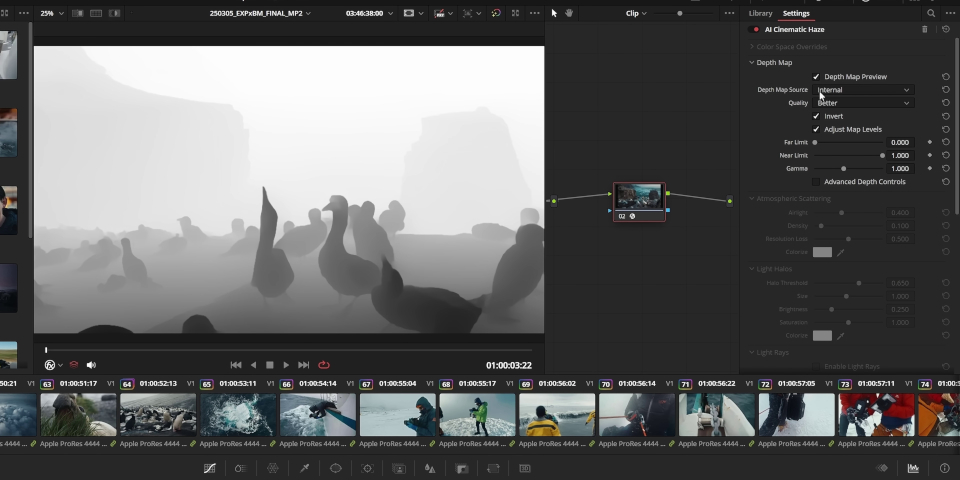Blackmagic Design releases DaVinci Resolve 20.2
Blackmagic Design has updated DaVinci Resolve, its free color grading, editing and post-production software, and DaVinci Resolve Studio, its $295 commercial edition.
DaVinci Resolve 20.2 extends support for Blackmagic’s Ursa Cine Immersive camera, adds support for decoding ProRes RAW clips, and improves ripple editing workflow.
Below, we’ve rounded up the key features for colorists and effects artists, including a new AI Cinematic Haze effect, and multi-layer support in the 3D renderer.

Color page and Resolve FX: new AI Cinematic Haze effect
DaVinci Resolve 20.2 features a number of updates to Resolve FX, the library of image-enhancement and effects plugins available from the software’s Color page.
The main new feature is the AI Cinematic Haze effect, which adds fog-like atmospheric scattering to a scene using an AI-generated depth map.
Artists can adjust the map using slider controls to set the near and far depth limits.
The look of the haze can then be adjusted with sets of control parameters to determine its intensity and halation, and to add effects like light rays and air disturbance for a smokier effect.
In addition, the Resolve FX Surface Tracker, which tracks organically deforming planar surfaces – for example, for adding logos to clothing – is now “up to 2x” faster.
All of the Resolve FX light effects also now support glow from alpha sources.

Fusion page: support for multilayer workflow in the 3D renderer
The Fusion page, DaVinci Resolve’s compositing toolset, gets support for multi-layer workflows in the 3D renderer.
It is now possible to preview the individual passes generated by the Renderer3D node in the viewer: the demo video shows Shadow, Diffuse, Specular, Ambient, Reflect, Refract and Fog passes.
USD workflows, introduced in DaVinci Resolve 18.5, have been extended, with the USD tools now supporting animated image inputs.
In addition, it is now possible to display and reposition layout guides in the Fusion page, and the alignment and transformation controls of the MultiText tool have been improved.
The release notes don’t go into detail, but the demo video mentions paragraph-level styling and the option to import .csv files as column-aligned MultiText text boxes, both introduced in DaVinci Resolve 20.1 last month when using the MultiText tool in the Cut and Edit pages.
Pipeline integration: extended codec and camera support
DaVinci Resolve 20.2 also introduces support for new codecs and image formats, the most significant being support for decoding ProRes RAW clips on macOS, Windows and Linux.
The update also improves support for Blackmagic Design’s new Ursa Cine Immersive camera, designed for capturing immersive video for display on Apple’s Vision Pro XR headsets.
The 20.1 release made it possible to monitor content shot on the camera on the Edit, Fusion and Color pages.
To that, 20.2 adds support for streaming from the Fusion page to the Vision Pro, and for immersive EXR workflows, “allowing for proxies and VFX turnovers while retaining [lens] metadata”.
Other toolsets
For video editors, the Cut and Edit pages get a number of workflow improvements, particularly for ripple editing and ripple trimming, and to the UI of the keyframe and curve editors.
We don’t cover video editing or audio mixing on CG Channel, but you can find details of the changes to the Cut and Edit and Fairlight pages via the links at the foot of this story.
Price, system requirements and release date
DaVinci Resolve 20.2 and DaVinci Resolve Studio 20.2 are compatible with Windows 10+, Rocky Linux 8.6, and macOS 14.0+. The updates are free to existing users.
New perpetual licenses of the base edition are also free.
The Studio edition, which raises the export resolution from 4K to 32K, and adds AI features, stereoscopic 3D tools, and collaboration features, costs $295.
Read a full list of new features in DaVinci Resolve 20.2 and DaVinci Resolve Studio 20.2
Have your say on this story by following CG Channel on Facebook, Instagram and X (formerly Twitter). As well as being able to comment on stories, followers of our social media accounts can see videos we don’t post on the site itself, including making-ofs for the latest VFX movies, animations, games cinematics and motion graphics projects.
